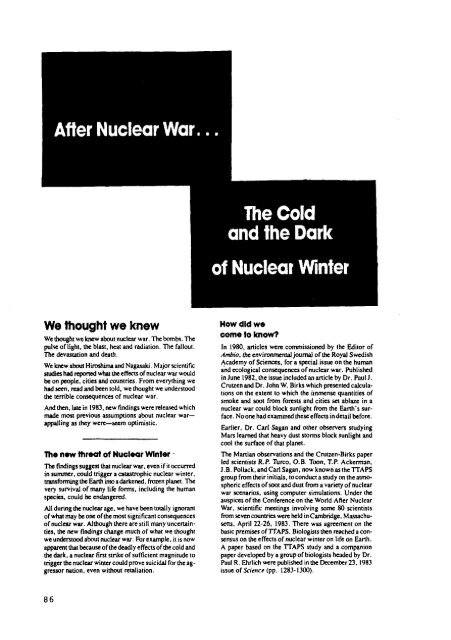Ifda dossier 47, May/June 1985
Ifda dossier 47, May/June 1985
Ifda dossier 47, May/June 1985
You also want an ePaper? Increase the reach of your titles
YUMPU automatically turns print PDFs into web optimized ePapers that Google loves.
We thought we knew<br />
We thought we knew about nuclear war. The bombs. The<br />
pulse of light, the blast, heat and radiation. The fallout.<br />
The devastation and death.<br />
We knew about Hiroshima and Nagasaki. Major scientific<br />
studies had reported what the effects of nuclear war would<br />
be on ~coole. cities and countries. From evervthine we<br />
had seen. kadand been told, we thought we understood<br />
the terrible consequences of nuclear war.<br />
And then. late in 1983, new findings were relca.ud which<br />
made most previous assumptions about nuclear war-<br />
appalling as they were-seem optimistic.<br />
The new threat of Nuclear Winter<br />
The findings suggest that nuclear war, even if it occurred<br />
in summer, could trigger a catastrophic nuclear winter.<br />
transforming the Earth into a darkened, frozen planet. The<br />
very survival of many life forms, including the human<br />
species, could be endangered.<br />
All during the nuclear age. we have been totally ignorant<br />
of what may beone of the most significant consequences<br />
of nuclear war. Although there are still many uncertainties,<br />
the new findings change much of what we thought<br />
we understood about nuclear war. For example, it is now<br />
apparent that because of the deadly effects of the cold and<br />
(he dark, a nuclear first strike of sufficient magnitude to<br />
trigger the nuclear winter could prove suicidal for the aggressor<br />
nation, even without retaliation.<br />
How did we<br />
come to know?<br />
In 1980, articles were commissioned by the Editor of<br />
Ambio, theenvironmental journal of the RoyaJ Swedish<br />
Academy of Sciences, for a special issue on the human<br />
ind ecological consequences of nuclear war. Published<br />
in <strong>June</strong> 1982. the issue included an article by Dr. Paul J<br />
Cmtzen and Dr. John W. Birks which orescnted - calcula- ~-<br />
tions on the extent to which the immense quantities of<br />
smoke and soot from forests and cities set ablaze in a<br />
nuclear war could block sunlight from the Earth's surface.<br />
Noone had examined these effects indetail before.<br />
Earlier. Dr. Carl Sagan and other observers studying<br />
Mars learned hat heavy dust storms block sunlight and<br />
cool the surface of that planet.<br />
The Martian observations and the Cmtzcn-Birks paper<br />
led scientists R.P. Turco. 0.0. Toon. T.P. Ackerman.<br />
J.B. Pollack, and Carl Sagan, now known as the TTAPS<br />
group from their initials. toconduct a study on the atmospheric<br />
effectsof soot and dust from a variety of nuclear<br />
war scenarios, using computer simulations. Under the<br />
auspices of the Conference on the World After Nuclear<br />
War. scientific meetings involving some 80 scientists<br />
from seven countries were held in Cambridge. Massachusens,<br />
April 22-26, 1983. There was agreement on the<br />
basic premises of TTAPS. Biologists then reached a consensus<br />
on the effects of nuclear winter on life on Earth.<br />
A paper based on the TTAPS study and a companion<br />
paper developed by a group of biologists headed by Dr.<br />
Paul R. Ehrlich were published in the December 23, 1983<br />
issue of 5cience (pp. 1283- 1300).
















